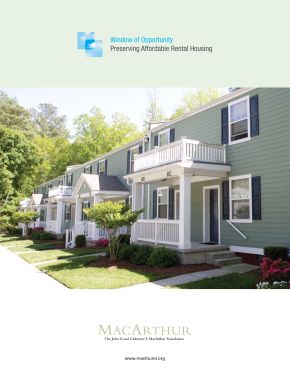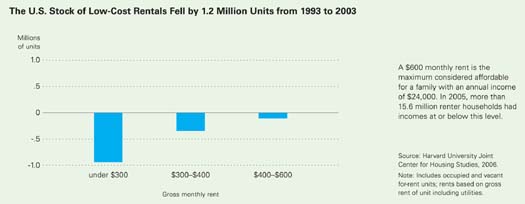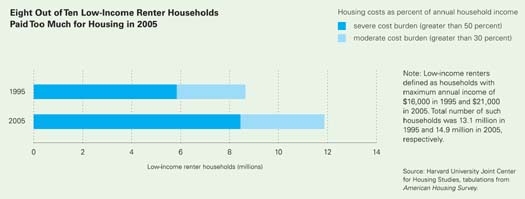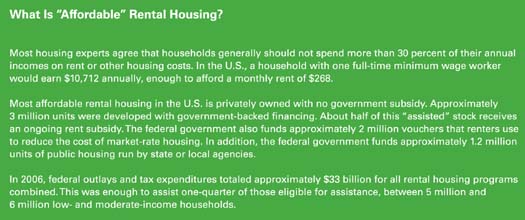
Almost all of us are renters at some point in our lives. Today, one-third of U.S. households, 37 million, rent their homes—from new college graduates to aging seniors and young families saving to buy their first place. Homeownership may be the American Dream, but for millions of people renting is the best or only option.

Growing challenges for U.S. renters. Millions of renters today have trouble finding a decent, stable and affordable home—especially one with ready access to work, transit and schools.
In 2005, almost 9 million low- and moderate-income renter households spent over half of their earnings on housing, a record high.
Part of the problem is that wages at the bottom of the economic ladder have not kept pace with rising rents. The stock of low-cost rental homes also has fallen due to demolition, condominium conversion and the expiration of government subsidies and affordability restrictions.
Billions of taxpayer dollars were invested over the past 50 years to create and maintain the rental homes that are being lost. Between 1993 and 2003, the number of housing units renting for $400 per month or less, in inflation-adjusted terms, declined by 1.2 million. If current trends continue, another 1 million low-cost rentals will be lost over the decade ahead.
Meanwhile, experts forecast that immigration, demographics and rising home foreclosures will cause the number of renter households to jump by almost 2 million.
Preserving and improving the affordable rental stock: smart economics, sound policy. Across the country, “preservation owners” are buying, recapitalizing and renovating existing rental properties, keeping them affordable and in good shape for another generation of use.
This helps low-income seniors remain in their homes near family and friends, retains rental housing in job-rich areas, and transforms troubled properties into safe, sustainable communities.
Recent preservation projects also prove that it can be faster, easier and cheaper to preserve and improve an existing property than to build a new one from the ground up.
Through the end of 2007, developers financed through the MacArthur Foundation’s Window of Opportunity initiative had preserved 45,000 affordable rental homes at an average per unit cost of $81,000—about half the cost to build a new rental apartment in the U.S. today.
More than housing is at stake. Research suggests that people who have stable, decent homes have an easier time holding down a job and their children do better in school. There also is evidence that a mix of quality housing options helps make communities more vibrant, diverse and livable.
As Window of Opportunity leaders have shown, preserving affordable rental housing today secures access to decent, stable and affordable housing for years to come while increasing the return on past public investments. In short, it’s a key part of the solution to our nation’s affordable housing problem.

Policies That Work
Across the country, state, local and federal policymakers are helping communities renew the existing stock of low-cost rental homes. Here are some ways they are making this happen.
Better information and coordination. The State of Florida built a database covering all government-assisted rental housing. Inter-governmental councils in the Twin Cities, Wisconsin, and Cook County, Illinois, help coordinate preservation activity. Cook County also has a tenant alliance providing outreach, education and support.
California, Texas and many other places have “early warning” laws that require owners to notify renters before they “opt out” of a federal subsidy program.
 More regulatory support and flexibility. In Illinois and Rhode Island, tenants or a state or local agency have the right to buy at-risk buildings facing conversion, usually in partnership with a developer.
More regulatory support and flexibility. In Illinois and Rhode Island, tenants or a state or local agency have the right to buy at-risk buildings facing conversion, usually in partnership with a developer.
The U.S. Department of Agriculture is revitalizing rental properties in rural areas by working with owners to restructure past loans and finance needed repairs.
At the U.S. Department of Housing and Urban Development, the Mark-to-Market program has adjusted rents, recapitalized properties and permitted changes to extend affordability and improve more than 260,000 low-cost rental homes since 1997.
Easier access to funding; new financial incentives. The National Housing Trust reports that 46 states set aside existing funds or give preservation owners extra points when they compete for tax credits, bonds and block grants.
A one-penny tax on real estate in Fairfax County, Virginia, raises $22 million annually, helping to preserve 2,200 at-risk affordable rental homes since 2004.
In Cook County, Illinois, owners of rental housing get a break on property taxes when they make needed repairs and keep their rents low. Following Missouri’s lead, Illinois also offers a “donations tax credit” that helps nonprofit buyers keep rental properties affordable.
New York City used $8 million to leverage a $200 million acquisition fund. Backed by a group of foundations and banks, the fund allows preservation owners to move quickly when buying at-risk properties.
Encouraging innovative, high-impact preservation strategies. Forward-looking policymakers across the U.S. are helping creative preservation owners address a range of community priorities, including supportive housing for the formerly homeless, assisted living for aging seniors, energy conservation and transit-oriented development.
Greater support for mission-driven owners. The STRENGTH MATTERS initiative of the Housing Partnership Network, Stewards of Affordable Housing for the Future, and NeighborWorks America is analyzing policies that limit the ability of nonprofit preservation owners to generate cash flow from their operations and build a capital base. Improvements in these policies would help owners pursue new developments, work to acquire and preserve affordable properties at scale, and provide resident services.

A New Commitment
The time has come for a new national commitment to affordable rental housing to help more renters with limited means find well-located and affordable homes and to ensure that urban, suburban and rural communities can retain a mix of quality housing options for years to come.
To realize this vision, the MacArthur Foundation is investing $150 million over 10 years through a national initiative, Window of Opportunity: Preserving Affordable Rental Housing.
Through this effort, we support policy analysis, data collection and expert assistance to encourage investment in rental housing and sound policies at federal, state and local levels.
We also provide funding for 25 mission-driven housing developers and public-sector preservation initiatives in Chicago, New York City and ten other states and localities across the country.
Combined, we expect these investments to directly help preserve and improve at least 300,000 affordable rental homes nationwide.
More broadly, our goal is to stimulate lasting housing policy reforms and new development and lending practices that:
- Make it easier, faster and more cost-effective for affordable rental property owners to retain and renew the existing stock;
- Reverse the loss of existing, affordable rental homes by providing resources and regulatory incentives to preserve at least 1 million units over the decade ahead.
The MacArthur Foundation is proud to pursue this vision in partnership with outstanding leaders in the nonprofit, for-profit and public sectors. We invite others to join us in the effort to meet this nation’s growing need for decent, stable and affordable housing.



